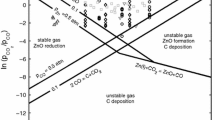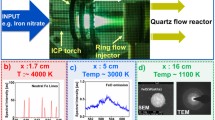Abstract
In order to predict the vaporization rate of fume-forming condensed phases into reactant-rich gases it is necessary to account for the strong augmentation of vapor transport rates caused by bulk flow into the reaction-condensation zone. For this purpose a simple film theory is developed based on the idealization of a thin reaction-condensation “front” supplied by convection-diffusion processes normal to the surface, but with condensate removal by convection processes parallel to the vaporizing surface. The steady-state position or “stand-off distance” of the front and, hence, its effect on the observed mass transfer rate, are determined by the demands of local reactant stoichiometry at the front and species conservation throughout the two-part film, subject to the imposed vapor and oxidizer boundary concentrations. As applied to the problem of metal vaporization into reactive atmospheres, it is shown that while we recover the results of Turkdogan, Grieveson, and Darken in highly dilute isothermal systems (i.e., metals far from their boiling points vaporizing into dilute oxygen-inert gas mixtures) appreciable additional effects due to the condensation process are predicted in the limit of oxidizer-rich ambient gases. Combining this extended theory with the notion that there is an upper limit to the attainable magnitude of the vaporization rate enhancement at which the reaction regime must change from homogeneous to heterogeneous, leads to predicted critical (transition) oxidizer pressures valid even approaching the practically important limit of pure gaseous ozidizer. On the assumption that this transition will occur when the metal vaporization rate approaches that expected in a vacuum (as has been experimentally observed by Turkdogan, Grieveson, and Darken), illustrative calculations are presented for the metals Na, Mg, Ca, Al, Be, Fe, and Zr vaporizing into oxygen-inert gas mixtures, and conclusions are drawn concerning the impossibility of the vapor phase reaction mode at surface temperatures too far below the metal boiling (or sublimation) point. It is also shown that the formalism can be extended to incorporate an alternative critical condition, perhaps more realistic under some experimental conditions, viz., oxygen penetration to the surface due to the finite thickness of the reaction zone. In either event, the model can be readily used to predict the homogeneous-heterogeneous transition locus and its dependence on the occurrence or nonoccurrence of product condensation, and physical, chemical, and aerodynamic parameters.
Similar content being viewed by others
Abbreviations
- B :
-
Mass transfer driving force parameter; Eq. (32)
- c P :
-
Specific heat (capacity)
- D i−j :
-
Fick binary diffusion coefficient for chemical species i and j
- D :
-
Oxidizer-to-metalDρ-ratio; Eq. (24)
- d :
-
Diameter; Eq. (26)
- E :
-
Activation energy of the metal oxidation homogeneous rate constant; Eq. (30)
- F RXN :
-
Reaction factor;m "/m "0
- G 1 :
-
Dimensionless temperature gradient function defined by Eq. (40)
- G 2 :
-
Dimensionless temperature gradient function defined by Eq. (41)
- h i :
-
Specific enthalpy of chemical species i
- I :
-
Inert (non-participating) gas
- k :
-
bimolecular reaction rate constant; Eq. (30)
- k :
-
Boltzmann constant
- Le :
-
Dimensionless transport group (Lewis number) defined by Eq. (43)
- ℒ :
-
Lewis number ratio defined by Eq. (42)
- m i :
-
Mass of a molecule of chemical species i
- ℳ i :
-
Molecular weight of chemical species i (gm/gm-mole)
- m "i :
-
Total mass flux of chemical species i (relative to observer fixed at y = 0).
- M :
-
Metal species
- Nu :
-
Nusselt number defining conditions of external heat/mass transport
- n i :
-
Number density of chemical species i
- O:
-
Oxidizer species
- p i :
-
Partial pressure of chemical species i
- p :
-
Total pressure (expressed in atmospheres)
- P :
-
Reaction product
- Q :
-
Heat of gas phase reaction (1) per unit mass of metal vapor; Eq. (38)
- r :
-
Mass of oxidizer that reacts with unit mass of metal vapor
- R :
-
Universal gas constant
- T :
-
Absolute temperature
- w ‴i :
-
Source strength for chemical species i due to homogeneous chemical reaction [(mass) (volume)−1 (time)−1]
- x :
-
Stoichiometric ratio of oxidizer to metal atoms in the resulting metal oxide
- Y i :
-
Local mass fraction of chemical species i
- y :
-
Distance measured normal to the vaporizing surface
- α :
-
Evaporation coefficient
- δ :
-
Effective film (boundary layer) thickness
- δ chem :
-
Effective thickness of the homogeneous metal-oxygen vapor reaction zone
- ε/k :
-
Energy well-depth parameter for the Lennard-Jones 6:12 potential
- Λ :
-
Molar heat of metal vaporization
- λ :
-
Thermal conductivity of gas mixture
- ρ :
-
Total mass density of gas mixture
- σ :
-
Molecular size parameter in the Lennard-Jones 6:12 potential
- bp:
-
At the boiling point corresponding to the prevailing total pressure
- B = 0:
-
In the absence of appreciable net interfacial mass transfer
- chem:
-
Pertaining to the reaction zone
- eq:
-
At local equilibrium
- e:
-
At the outer edge of the film (boundary layer)
- eff:
-
Effective value
- f:
-
At the reaction “front” (cf. Fig. 1)
- M:
-
Pertaining to the metal
- MO:
-
Pertaining to the metal oxide
- mp:
-
At the equilibrium melting point
- RXN:
-
In the presence of homogeneous chemical reaction
- vac:
-
Into a vacuum (absence of “background” gas)
- w:
-
At the gas-metal interface (cf. Fig. 1)
- 1:
-
In zone 1 (0 <y <y f); cf. Fig. 1
- 2:
-
In zone 2 (y f <y < Δ); cf. Fig. 1
- *:
-
Pertaining to the critical (transition) condition from homogeneous to heterogeneous chemical reaction
- o:
-
In the absence of homogeneous chemical reaction
- \(\overline {\left( {} \right)} \) :
-
Average value
- +:
-
On + side
- −:
-
On − side
- (s):
-
Solid phase
- (c):
-
Condensed phase
- (g):
-
Gaseous (vapor) phase
- Δ():
-
Change in
References
T. K. Sherwood and R. L. Pigford,Absorption and Extraction, 2nd ed. (McGraw-Hill Book Co., New York, 1952);
P. V. Danckwerts,Gas-Liquid Reactions (McGraw-Hill Book Co., New York, 1970).
G. Astarita,Mass Transfer with Chemical Reaction (Elsevier, Amsterdam, 1967).
S. Hatta, Technol. Rep. Tohoku Univ., 1928–29, 8, 1. Idem.,ibid, 1932, 10, 119.
E. T. Turkdogan, P. Grieveson, and L. S. Darken,J. Phys. Chern. 67, 1647–1654 (1963).
D. E. Rosner,Int. J. Heat Mass Transfer 10, 1267–1279 (1967).
D. E. Rosner and M. Epstein,Trans. Met. Soc. AIME 242, 2355–2357 (1968).
M. Epstein and D. E. Rosner,Int. J. Heat Mass Transfer 13, 1393–1414 (1970).
C. Wagner,Corrosion Sci. 5, 751–764 (1965).
O. Knacke and I. N. Stranski,Progress in Metal Physics, Vol. 6 (Pergarnon Press, London, 1956), p. 181.
D. B. Spalding,Convective Mass Transfer—An Introduction (McGraw-Hill Book Co., New York, 1963).
R. B. Bird, W. E. Stewart, and E. N. Lightfoot,Transport Phenomena (John Wiley & Sons, New York, 1960).
R. A. Svehla, Report No. R-132, NASA, Washington, D.C., 1962.
E. T. Turkdogan, inProc. J. Chipman Conference on the Physical Chemistry and Technology of Steelmaking, June 4, 1962.
P. Grieveson and E. T. Turkdogan,J. Phys. Chem. 68, 1547–1552 (1964).
J. O. Hirschfelder, C. F. Curtiss, and R. B. Bird,Molecular Theory of Gases and Liquids (John Wiley & Sons, New York, 1954).
O. Kubaschewski, E. W. Evans, and C. B. Alcock,Metallurgical Thermochemistry, 4th ed. (Pergamon Press, Oxford, 1967).
L. S. Nelson, H. S. Levine, D. E. Rosner, and S. C. Kurzius, inTwelfth Symposium (International) on Combustion, The Combustion Institute, Pittsburgh, Pa., 1969.
L. S. Nelson, H. S. Levine, D. E. Rosner, and S. C. Kurzius,High Temp. Sci. 2, 343–375 (1970).
D. B. Spalding,Some Fundamentals of Combustion, Gas Turbine Series Vol. 2 (Academic Press, New York, 1955).
I. Glassman, inSold Propellant Rocket Research (Academic Press, New York, 1960), pp. 253–258.
A. Liñan, Report No. TRFM632, AFOSR 64 0151 DDC AD 43 2822, Inst. Nacional de Tecnica Aeronautica, Spain, 1963.
S. K. Friedlander and K. H. Keller,Chem. Eng. Sci. 18, 365–375 (1963).
F. E. Fendell,Chem. Eng. Sci. 22, 1829–1837 (1967).
J. Szekely,Chem. Eng. Sci. 22, 777–779 (1967).
JANAF Thermochemical Tables, Dow Chemical Co., Midland, Michigan, 1966, Report PB 168 370-1 Clearinghouse for Federal Scientific and Technical Information, Arlington, Va.
M. S. Chandrasekharaiah, Appendix B ofCharacterization of High Temperature Vapors, J. L. Margrave, ed. (John Wiley and Sons, New York, 1967), p. 497.
T. A. Brzustowski and I. Glassman, inHeterogeneous Combustion Vol. 15 ofProgress in Astronautics and Aeronautics (Academic Press, New York, 1964), pp. 75–115.
K. G. Denbigh and G. S. G. Beveridge,Trans. Inst. Chem. Eng. 40, 23–34 (1962).
Author information
Authors and Affiliations
Additional information
Supported by the U.S. Air Force Office of Scientific Research, Propulsion Division, under contract F44 620-70-C-0026.
Rights and permissions
About this article
Cite this article
Rosner, D.E. Effects of product condensation on reaction-enhanced vaporization rates and on the transition from homogeneous to heterogeneous reaction in high-temperature metal oxidation. Oxid Met 4, 1–25 (1972). https://doi.org/10.1007/BF00612504
Received:
Revised:
Issue Date:
DOI: https://doi.org/10.1007/BF00612504




